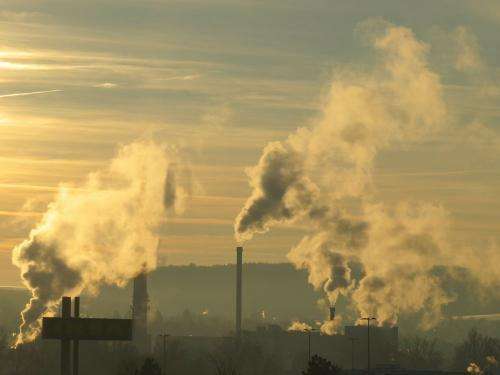Addressing India's air quality, health and climate requires public action, study finds

Just weeks after New York City saw the largest climate march in history, new research shows that such public demand can have a direct impact on environmental improvements and associated health benefits.
The study, published in the October issue of the American Economic Review, specifically looks at India and uses the country as a baseline for similar developing economies that are dealing with extreme pollution concentrations and are significant greenhouse gas emitters.
In India, levels of particulate matter concentration—a deadly form of pollution—are five times the levels in the U.S. According to a World Health Organization report released in May, Delhi's particulates pollution was almost three times higher than Beijing's between 2008 and 2013.
"Effective environmental regulations in India are vital for the hundreds of millions of Indians who are seeing their life expectancy cut short due to high air pollution. And if India chooses to regulate greenhouse gases, it will be important for the world as India increasingly becomes a major emitter of greenhouse gases," said University of Chicago economist Michael Greenstone, co-author of the study and the director of the Energy Policy Institute at Chicago. "We find that when it comes to enforcing its strong environmental regulations, India has a mixed track record."
To perform the analysis, Greenstone and co-author Rema Hanna, an associate professor at the Harvard Kennedy School of Government, compiled the first city-level data of its kind in India, tracking air and water pollution, environmental regulations and infant mortality over two decades. This resulted in the most comprehensive developing country dataset ever gathered on the topic. They found that environmental policies can be effective, but are not always. Air quality regulations, for instance those requiring new cars to have catalytic converters, reduced air pollution. In contrast, water pollution regulations were not associated with improvements in any of the available measures of water quality.
Greenstone and Hanna also explored why air regulations were more successful than the water policies. For example, they studied content from the Times of India, the country's leading English-language newspaper, and found three times more reports on air pollution than water pollution. High levels of citizen engagement persuaded India's Supreme Court to become active in the implementation and enforcement of the air regulations. Such engagement did not exist toward water policies. This may be because filters and bottled water offer relatively inexpensive protection against polluted water.
"Our conclusion is that the relative success of the air regulations is due to a greater demand for improvements in air quality by India's citizens. This demand seems to have prodded government into action," Hanna said. "It is noteworthy that public demand for improvements in air quality remains behind that in China, where wearing a face mask is considered normal and public unrest has led to Chinese Premier Li Keqiang calling for a 'war on pollution'."
India's Prime Minister Narendra Modi recently signaled that his primary concern is economic development, not controlling pollution. Reflecting this focus, a committee is currently reviewing the country's five major environmental laws in order to streamline environmental clearance processes that are seen as thwarting growth. The committee was given two months—closing at the end of October—to make their proposals.
But Greenstone said past studies have shown that environmental improvements in developing countries can lead to longer and healthier lives, which are critical ingredients for economic growth. For example, in a study released last year, Greenstone found that people who live in northern China are set to lose a total of 2.5 billion years of life expectancy compared to those living in the south, due to the extensive use of coal in power boilers for heating north of the Huai River. Additionally, in a study of Mexico City, Hanna found that rising pollution decreased the number of labor hours worked.
"The Government of India has a tremendous opportunity to improve the health of its citizens by reducing air pollution," Greenstone said. "And we now know that this is feasible because environmental regulations have been shown to work in India when the public demands them. We can also draw from these results that no matter what climate deals are worked out internationally, India seems unlikely to significantly reduce greenhouse gas emissions unless its people consider climate change an urgent issue and strongly call for action."
More information: Greenstone, Michael, and Rema Hanna. 2014. "Environmental Regulations, Air and Water Pollution, and Infant Mortality in India." American Economic Review, 104(10): 3038-72. DOI: 10.1257/aer.104.10.3038
Journal information: American Economic Review
Provided by University of Chicago

















